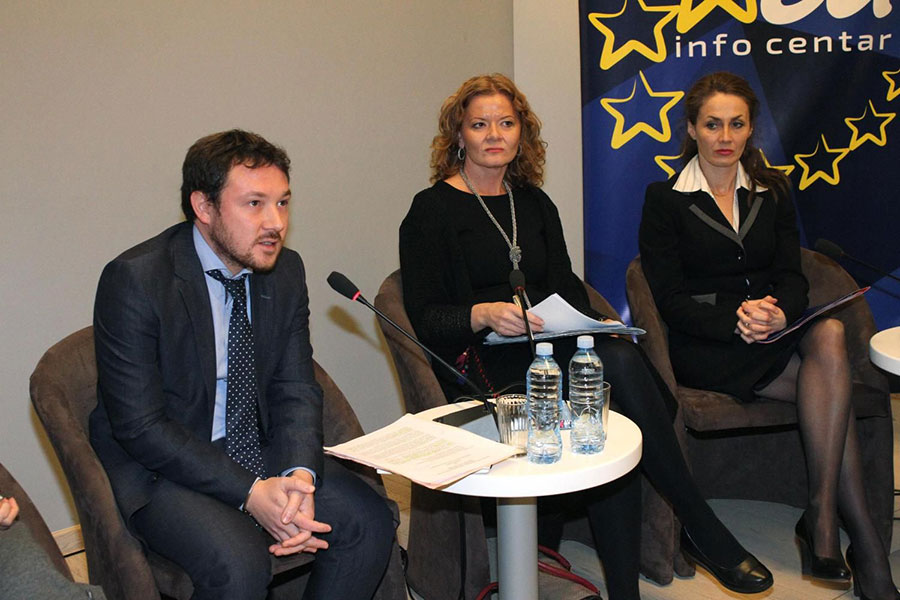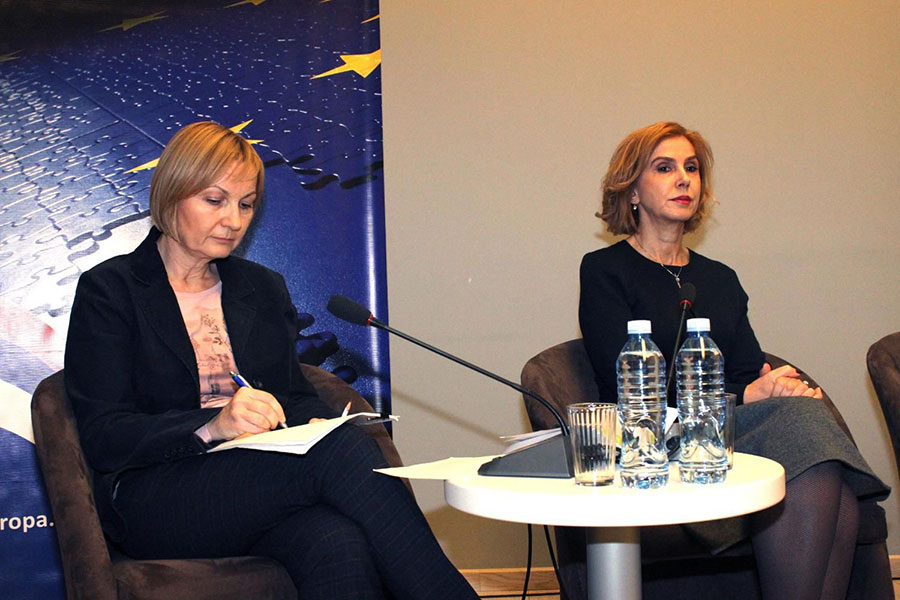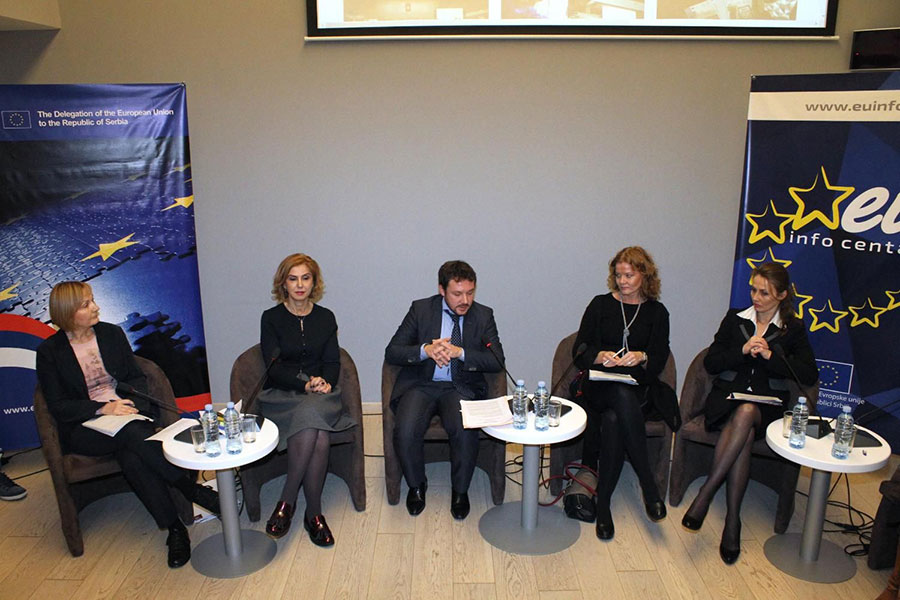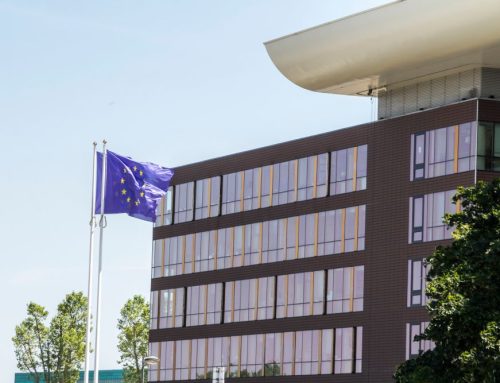Ahead of International Day for Elimination of Violence Against Women, the EU Info Centre hosted a debate titled What is the response to violence. The participants in the debate stressed that in the past 10 years 327 women were killed in Serbia, adding that in 2015 alone centres for social work received 18,746 reports of violence. Participants also underlined that in order to tackle the issue, it was necessary to establish cooperation and information sharing among competent institutions.
Participants in the debate agreed that the new solutions to the Draft Law on Prevention of Domestic Violence, which is currently in parliamentary procedure, will mark a shift, adding that failing to implement the Law would be dangerous.
Bizel: One in three women in the EU experienced violence
Head of the sector for justice, internal affairs and support to civil society at the EU Delegation to Serbia Nicolas Bizel said that Serbia’s readiness to tackle the issue of domestic violence was a good thing, despite the fact that the process was lengthy and time-consuming, required money and workforce and equal commitment from both women and men.
He said the EU would help Serbia to build the capacity of both national institutions and non-governmental organisations, adding that the EU itself was working to address this issue as the gender equality in EU Member States was yet to reach a satisfactory level. He said that the elimination of violence against women was at the centre of efforts of all European countries, adding the statistical data pointed there was still room for improvement.

FoNet
Bizel said that statistical data suggested that one in three women in the EU had experienced some form of gender-based violence, that a number of underage girls had been married or had experienced physical abuse during their childhood and that a large number of women were killed by their partners.
”It is necessary to spread goodwill and raise awareness of the issue not only outside the EU, but also inside the Union,” said Bizel and added that the EU aimed at stepping up the fight against that form of violence through its external policy and the provision of financial assistance.
Jankovic: Discrimination and gender inequality root causes of violence against women
Commissioner for Protection of Equality Brankica Jankovic said that gender inequality lied at the heart of gender-based violence in Serbia.
The National Assembly is currently making amendments to the legal framework and, as she put it, even if we establish a perfect system of protection from domestic violence, we will be stuck with a root cause, that is the deeply entrenched gender-based discrimination and patriarchy.
We will have zero tolerance of violence only once we have zero discrimination, the Commissioner said.
She said that a couple of years ago, a certain European media campaign claimed that domestic violence was the leading cause of death among women, meaning that more women are killed by their partners than in car accidents.
Jankovic said that in 2015 the centres for social work across Serbia had 18,746 cases of reported violence, not all of which have been processed.

FoNet
She said that the number of reported cases was growing year after year, adding that 46 percent of the cases involved physical abuse, 30 percent psychological abuse, whereas the rest of the cases dealt with verbal abuse and other forms of violence.
According to her, until some ten years ago no records were kept of cases of verbal and psychological abuse. In that context, she adds, a significant progress was made but at the same time it is the reason why there is no comparative data.
Ignjatovic: Biggest threat to women’s safety is at home
Advisor to the Vice-President of Serbian Government Branka Draskovic said that this year on the occasion of International Day for Elimination of Violence against Women, the Coordination Body for Gender Equality was launching a 16-day campaign aimed at raising awareness, primarily among youth, and announced the Strategy on violence and setting up of SOS hot line.
The biggest threat to women’s safety is at home, said the President of Autonomous Women’s Centre Tanja Ignjatovic.
Children accounted for 35 percent of victims, that is 6,500, in 2015 alone, she said. She added that the centres for social work initiated judicial proceedings in as little as 10 percent of all cases.
When it comes to adult victims, judicial proceeding were initiated in only 3.2 percent of cases.
According to her, in 2014, there were as many as 6,500 criminal charges filed, 51 percent of which have been dismissed.
The number of dismissed charges has increased even more once the prosecutors started applying the principle of opportunity of criminal prosecution and imposing fines, she said. She added that the money collected this way was not used to protect a new round of victims, even though it amounted to 40 million.
It really means a lot to women when the Vice-President of the Government, who at the same time is the Head of Coordination Body for Gender Equality, encourages women to report violence, she said and added that the system, unfortunately, cannot process the entirety of reported cases.
Stevanovic: Response from government institutions generally inadequate
Deputy Ombudsman Gordana Stevanovic stressed the importance of strengthening women and encouraging them to report violence, and pointed to the discouraging fact that response from government institutions was generally inadequate.
In 12 out of 14 cases of femicide, we have identified shortcomings in the work of competent authorities, Stevanovic said.
In 65 cases of violence handled by the Office of Ombudsman, women had reported violence, but the system failed to respond to those reports.
Apart from the lack of coordination among institutions, the main issue was the mild penal policy and a small number of those who are found guilty. She adds that even when they are found guilty and sentenced, their sentences are suspended.
Jelena Tadzic of UNDP talked about projects implemented by this organisation in Serbia aimed at strengthening women and institutions to stand up to and fight violence.
The participants in the debate paid articular attention to the role of the media in Serbia and said that the media most often failed to recognise violence or even denied or tolerated it.




